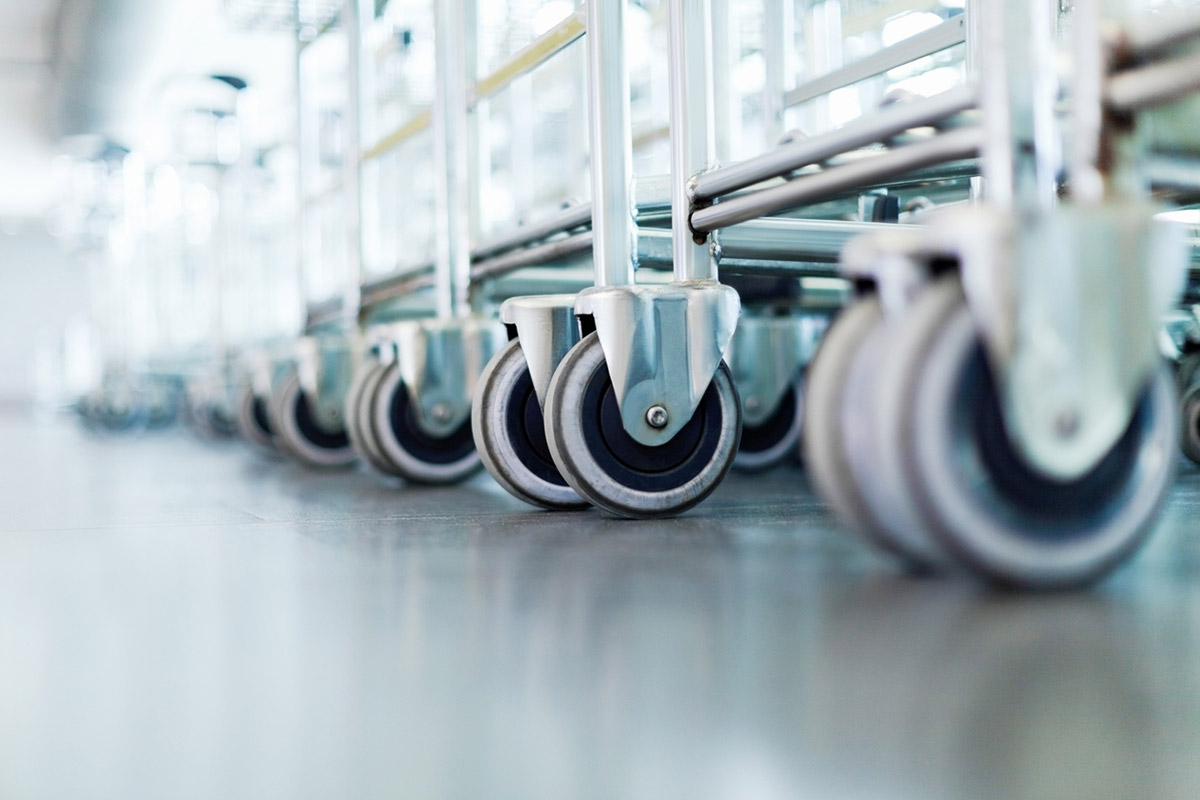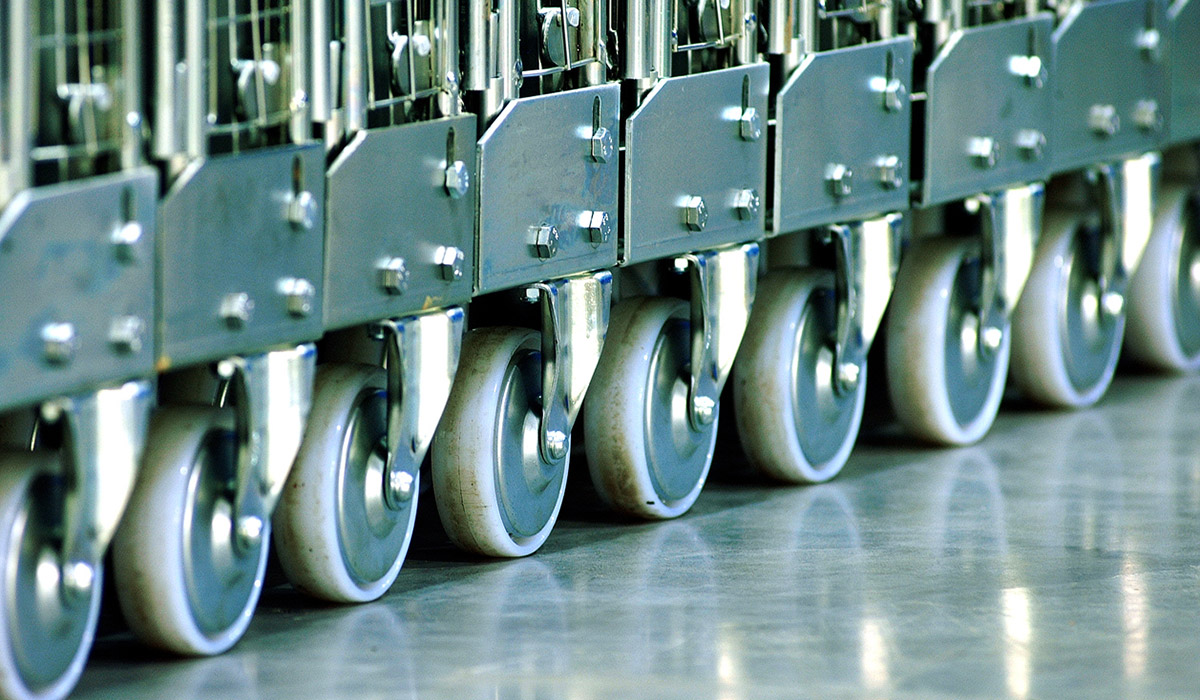
In the latest blog from Schaumburg Specialties, we share some top tips on what to consider when choosing casters for commercial food production equipment. From advice on maintenance to selecting the right size, you can read all about it in this week’s addition to our Learning Center. Thank us later!
Casters make the food industry (and lots of other industries, for that matter) go round – literally. Providing wheels to help your equipment move freely around your production space, casters can make that critical difference between a free-flowing commercial kitchen and one which is slow-moving and an obstacle to efficiency and profitability. There’s an old saying in the business: “50% of making something is moving its pieces around”, and that’s definitely the truth in a commercial kitchen.
Before we get into the nitty-gritty, let’s answer one question first.
What are Casters?
Containing a wheel and a bracket, casters can be mounted on to equipment so that they can be moved. A caster is more than just a wheel. Whilst a wheel spins around an axel, a caster contains a flat bracket, plate or stem which allows it to be fixed onto a piece of equipment.
In terms of ancillary commercial food production equipment, casters can be commonly found on racks, trolleys, dollies, carts and more.
What Kind of Casters Do I Need?

The kind of casters you’ll need will largely depend on what you need to move, how much you need to move and where you need to move it to: it’s quite simple.
If you’re a procurement professional or a business simply looking to outfit their commercial food production environment or commissary-style kitchen, you’ll need to choose a caster that works for you. Generally, you will be presented with a choice of two styles: plate mounted and stem mounted.
- Plate mounted: A plate mounted caster comes with a flat bracket with mounting holes. With this option, you can fasten another flat surface right up against it.
- Stem mounted: A stem mounted caster attaches via a post or rod (stem) that fits up or alongside the structure. Stems have different methods of securing them from falling out; from nut and bolt to grip ring and threaded.
These are the two main styles of caster, which can in turn be divided into two categories: swivel and rigid. In the next section of this blog, we highlight the various features and benefits offered by both options. Keep reading to learn more!
Do I Need Swivel Casters or Rigid Casters?

Before you make any big decisions, you’ll need to be sure what exact kind of caster you’ll need: rigid or swivel. So – what’s the difference between a swivel caster and a rigid caster? That’s easy:
-
Swivel casters
If you don’t know what a swivel caster is, the clue is in the name! These casters are designed so that the wheel can rotate 360 degrees while carrying a load. The middle of the wheel revolves around the center of the swivel, making it much easier to move heavy loads. This kind of caster offers ultimate manoeuvrability, allowing you to turn tight corners with ease.
-
Rigid casters
Commonly referred to as ‘fixed’ casters, rigid casters are essentially a wheel mounted between the legs of a bracket which DOESN’T swivel. This means that it can only move backward and forwards in a straight line, with no ability to turn a corner.
Both of these options carry unique features that you’ll definitely want, depending on the nature, size and scale of your commercial food production environment. The biggest advantage of rigid casters is that they provide a steerable object that is sometimes easier to move in a desired direction, whereas swivel casters can be difficult to propel in a straight line.
If you’re only ever moving your equipment backward and forward along a straight path, a rigid caster will provide all the functionality you need with some serious strength behind it. Meanwhile, if you need to move your equipment around freely and turn corners, a swivel caster will be necessary.
So, now you understand the difference between various options of caster. But what option is best for your business? To make this decision-making process as stress-free as possible, we’re sharing some key questions you should ask yourself first!
What Casters Do I Need: Questions to Consider

Before you make any big decisions on your choice of caster, stop and ask yourself these key questions first:
Question #1: What Manoeuvrability Will I Need?
Being able to move your products around is business critical. If you need to move your equipment into tight spaces, you’ll need to have 4 swivel casters. Meanwhile, if you need to go longer distances with more control of the path travelled, a combination of rigid and swivel casters could be a better choice as they steer your equipment in a straight line
Question #2: How Does it Mount?
Next, you’ll need to know how your choice of caster would be mounted onto your ancillary commercial food production equipment. As mentioned previously in this blog, you have two mounting methods: stem and plate. Knowing the answer to this question will help you answer the questions which follow!
Question #3: What Kind of Environment Am I Working In?
This question is particularly important, and will determine whether you’ll need high-temperature, heavy duty casters. Before clicking ‘purchase’, ask yourself some questions about your production environment. Is it wet? Is it hot? Is it cold? Is it acidic? Is the floor rough or smooth? Answering these questions can help you make a sound purchasing decision.
Question #4: What Size of Caster Would Be Most Suitable?
The next question on our list concerns what size of caster should be specified. When you’re talking about casters, the general rule of thumb is that bigger is better, because they typically last longer and roll better. They also carry more weight. As you go up in size, everything gets bigger and heavier = so choose a caster that works best with your cart based on height, carry weight and mounting method.
Question #5: How Much Am I Willing to Invest?
How much are you willing to invest in your casters; both in terms of purchasing them in the first place and keeping them properly maintained? These are key considerations you should make before making any major buying decisions. Are you willing to invest time and resources into maintaining your casters for a long time – and how long is a long time in business terms? Aside from that, there’s that question of economy, with the easiest way to cut costs being to put a cheaper caster on. Are you willing to invest in a strong caster that can stand the test of time and heavy usage?
That concludes our advice on what to consider when choosing casters for commercial food production equipment. To view our full range of available casters,
click here.
Move Your Equipment Your Way with the Perfect Equipment Casters
Here at Schaumburg Specialties, we’re passionate about supplying the industrial food production sector with products that can transform efficiency, productivity and profitability. To get started with your bespoke ancillary food prep equipment project, browse the full SHOPCraft product selection or contact us to discuss your unique requirements. Alternatively, submit your own drawings for a free quote.